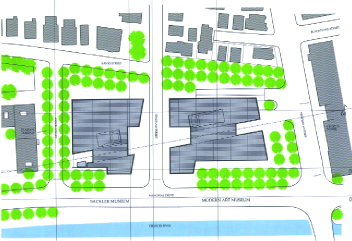The garden center that leases a 2.3-acre piece of Cambridge riverfront from Harvard is bringing out its flats of marigolds and petunias for another season, while architect Renzo Piano in Genoa, Italy, draws increasingly refined plans for the pair of art museums that the University hopes to build on the site (see "New Riverfront Museums, Housing?" November-December 1999, page 90).
A Harvard planning committee floated the proposal in 1999. It called for a new building to house a new museum of modern and contemporary art and a second new building to which the present Sackler Museum--for ancient, Asian, Islamic, and later Indian art--would move, freeing its present building near the Fogg Art Museum for purely academic use. A suggestion that the site might also include 50 to 100 units of University housing was later dropped.
The site is bordered on the east by Western Avenue and the Cambridge Electric Light Company, on the west by the multi-height housing complex primarily for married Harvard students called Peabody Terrace, in front by Memorial Drive and the Charles River, and in back by wooden houses, the so-called double-deckers and triple-deckers characteristic of the large, mostly residential Riverside section of Cambridge.
Piano's architectural drawings show two buildings rising 45 feet above grade, the height of the tallest triple-decker behind and the lowest building in the Peabody Terrace complex--and far below the 120 feet that zoning regulations would permit. Hingham Street will run through the property as it does now, connecting the neighborhood houses to Memorial Drive and the river, but its breadth will be increased as it passes between the two museums, whose entrances will open off it. The museum buildings will be set back from the houses by 50 to 70 feet and will be garlanded by trees, with a double row of trees at the back.
From the outside, the buildings as conceived appear to consist of two tall stories above ground. The lower one is mostly glass. The upper one presents a plain, unbroken wood surface, perhaps clapboards, and seems to float above the glass. The look is one of simple elegance.
Inside, the buildings are inter-floored so that some spaces are 20 feet high, some 10, accommodating galleries, a café, lecture halls, seminar rooms, a conservation laboratory, and offices. Two floors below grade connect the two buildings. The first contains a gallery for changing exhibits, a book shop, an auditorium, and so on. Care has been taken to open the floor to the one above, generously, to admit natural light and dispel a sense that one is in a basement. The bottom floor provides parking for 80 to 100 cars. Altogether, the structure offers 160,000 square feet of program space.
Are the museums big enough to meet Harvard's needs in the foreseeable future? "They are as big as we need, as big as we can afford, and as big as they should be," says James Cuno, Cabot director of the University Art Museums. "We want to exhibit art in intimate spaces with natural light, which we couldn't do if we built higher. And it doesn't meet our interests to fill the site with buildings. We want a setting within trees."
Last autumn the Cambridge City Council, responding to a neighborhood request, enacted an 18-month moratorium on developing the site. "Neighborhood people were concerned about the University's proposal," says Mary Power, senior director of community relations. "They raised questions about traffic, and parking, and the view, and air, and the water table. They needed time to figure out what they thought should happen on that site and in the Riverside area in general."
The issue is not only neighborhood distrust of Harvard. Power notes that when any development is proposed by anyone anywhere in Cambridge these days, people think their neighborhoods are being taken away from them. "The people of Riverside needed time, rightly, to organize so as to be able to best represent their interests in negotiations with Harvard," says Cuno.
A Riverside Neighborhood Association is being formed, Power reports. That's useful all around, she thinks, because it will give the neighborhood a cogent voice. Also hatched at the time the moratorium was passed, and now taking shape, is the Riverside Study Committee, whose members will include residents of the area, people doing business in it, and a representative of Harvard. The committee will make planning recommendations, and Power hopes that it will have reached some conclusions by the time the moratorium expires.
Cuno believes the museums will be built. "It's a reasonable proposal," he says. "We want to convert the use of the site from a commercial to a cultural purpose. The plan is sensitive architecturally and programmatically."
Construction could not begin for 18 months to two years after the moratorium ends, says Cuno, because time will be needed for final design development, for regulatory compliance, for fundraising. He expects the museums to open their doors five to six years from now.
 |
| A model of the proposed museum buildings on Memorial Drive, in a seagull's-eye view from the Charles (above), and (below) their footprint. Part of the Peabody Terrace complex is at left. Behind the museums are residential buildings of the neighborhood. At right are Western Avenue, a bit of the bridge that crosses the river there, and the power plant. |
|
|
| Images courtesy of Harvard University Art Museums |
 |
| Automobiles will enter off Memorial Drive, discharge passengers at the museums' doors on Hingham Street, descend a ramp in back to the garage, and depart onto Western Avenue, not penetrating the neighborhood behind. Trucks will enter from Western Avenue to a loading dock at that end and exit back onto that busy artery. |
| Images courtesy of Harvard University Art Museums |






